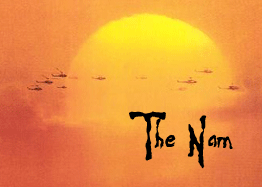
|
TheNam /
The Navy SEALTrailIndexPage | HomePage | Rules | Character Creation | Character Types | SEAL The most feared animal in the jungles of Vietnam is the Navy SEAL. The Vietcong and the NVA live in terror of the "men with green faces" who appear suddenly in the night from nowhere. SEAL ambush and prisoner snatch operations take place well back from main rivers and trails, deep inside enemy held territory. Using weapons ranging from crossbows tro machine guns SEALs bring a personal war to the enemy in a previously safe area. The United States Navy Sea, Air and Land (SEAL) forces are the elite Special Forces of the U.S. Navy, employed in unconventional warfare, foreign internal defence, direct action, Counter-Terrorism, and special reconnaissance operations. Those qualifying to become Navy SEALs are authorised, after completing a specialised programme known as SQT (SEAL Qualification Training), to wear and display the Special Warfare Badge, also known as the SEAL Trident. This badge (sometimes called “the Budweiser” for its resemblance to the Anheuser-Busch eagle logo) serves as the insignia for the SEALs as a whole and is the largest and most recognisable warfare insignia among U.S. Special Operations Forces. It is usually worn along with the U.S. Navy paratrooper wings, which are awarded after 10 jumps. During the Vietnam War, SEAL members wear “tiger stripe” camouflage uniforms, often with civilian blue jeans and “coral” sneakers, for patrol missions. On base, they wear standard uniforms with a black beret. The SEALs patrol along with the "brown water navy", alongside the Swift and STAB boat units, bringing terror to Vietcong and NVA units deep behind enemy lines. They are highly trained individuals, put through strenuous physical, mental, and emotional training during their Basic Underwater Demolition/SEAL (BUD/S) training, conducted at the Naval Special Warfare Center in Coronado (San Diego, CA) lasting 26 weeks. SEAL training and duty is voluntary. Many BUD/S students find that they do not have the desire to continue to endure the physical and mental strain of training, and subsequently Drop On Request, or DOR, from the course. The tradition of DOR consists of dropping one's helmet liner next to a pole with a brass ship’s bell attached to it, and ringing the bell three times. Classes typically lose around 70–80% of their trainees — either due to DORs or injuries sustained during training. The Navy will not release exact numbers, either percentages or raw figures, of the attrition rate for BUD/S. Most trainees are eliminated prior to completion of Hell Week and far fewer “brown shirts” (those who have made it through Hell Week wear brown t-shirts instead of white) quit the BUD/S program. After BUD/S, students must then attend the Navy’s Strategic Air Operations (SAO) school in the desert outside of San Diego. The Army trains Navy Special Warfare teams to freefall. Upon completion of the three-week SAO school, they receive their Naval Special Warfare Classification (NEC) code. Finally, the last requirement before going to a team requires students to go through SEAL Qualification Training, or SQT, which is a 15-week course. This course is also conducted in and around the Naval Amphibious Base Coronado. After completion of SQT training, students are then considered SEALs and are awarded the SEAL pin, or Trident. Upon assignment to a team, the new SEALs undergo more advanced training during the 18 month work-up to their first 6 month deployment and are not considered experienced until having completed at least three deployments. Category: TheNam |